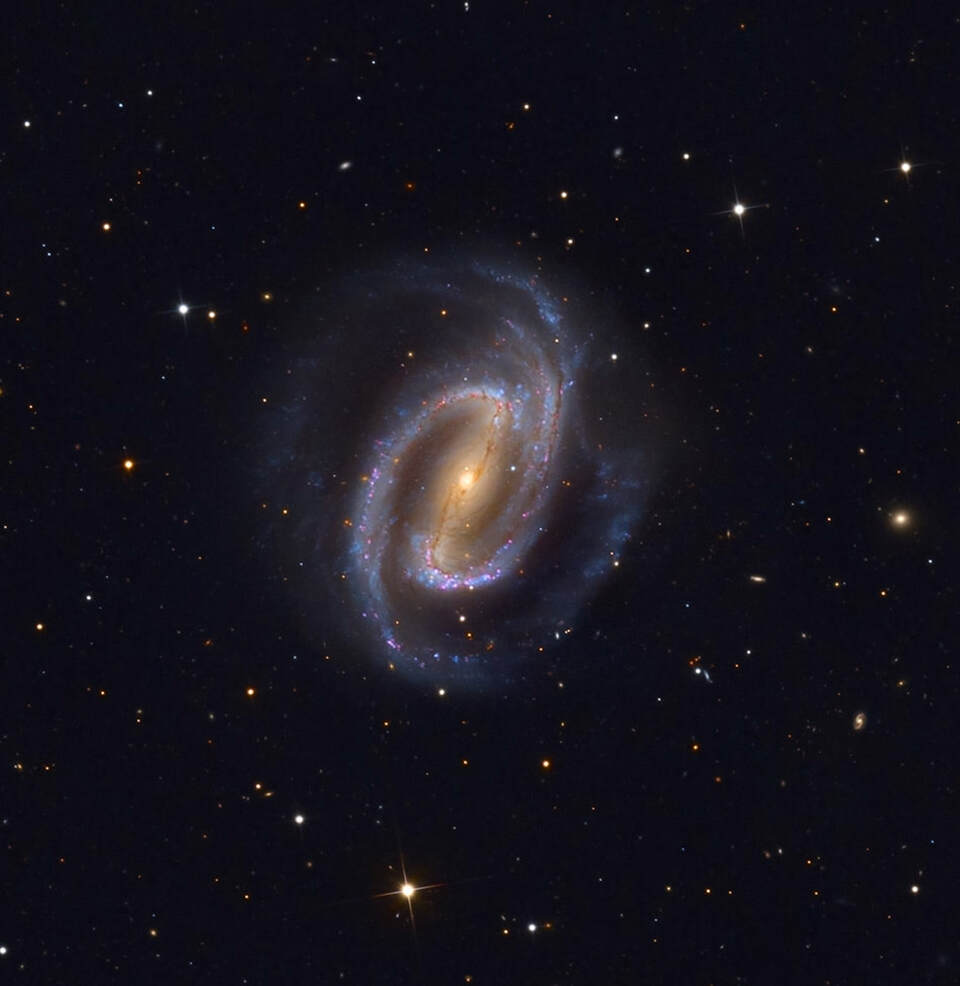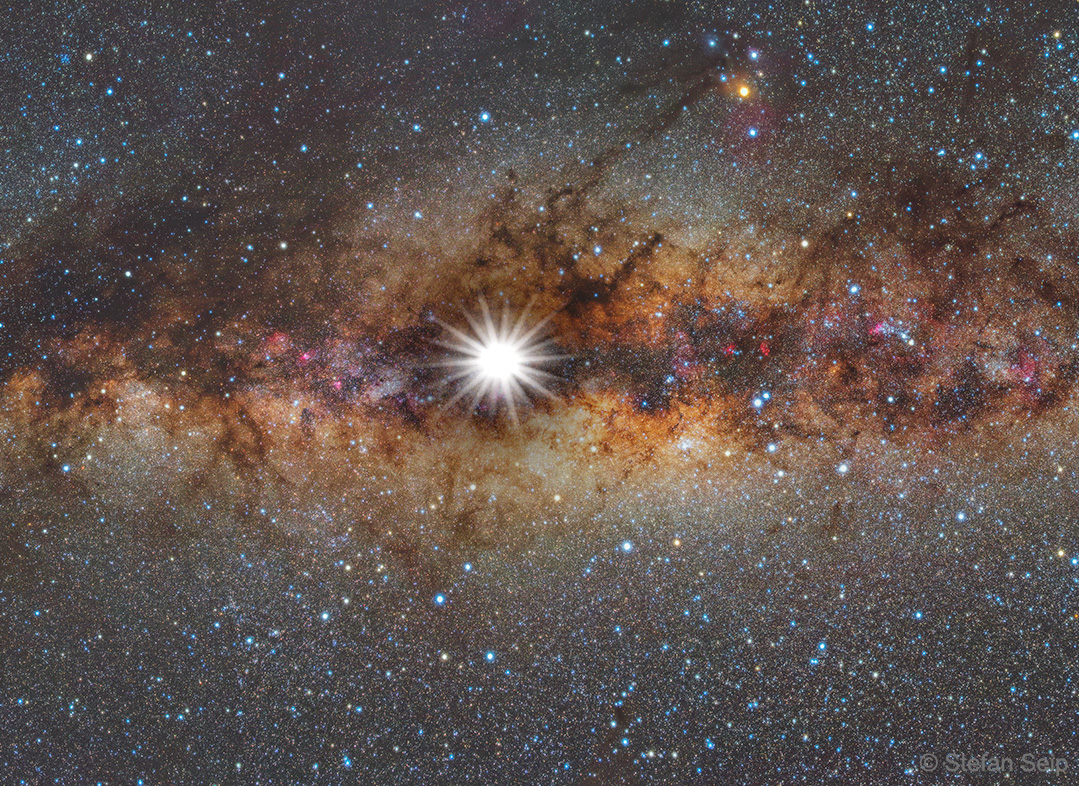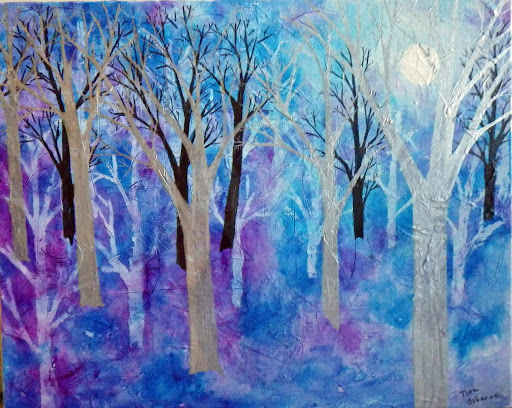Blog
NGC 3614 is the name of a barred spiral galaxy of the Hubble type SAB (r) c in the constellation Great Bear. It is an estimated 106 million light years away from the Milky Way and has a diameter of around 145,000 ly. It forms an optical duo with the galaxy PGC 34562. The object was discovered on February 5, 1788 by the astronomer William Herschel using his 18.7 -inch mirror telescope.

James Timothy Hardin (December 23, 1941 – December 29, 1980) was an American folk and blues musician and composer. As well as releasing his own material, several of his songs, including “If I Were a Carpenter“, became hits for other artists.
Hardin grew up in Oregon and joined the Marine Corps. He started his music career in Greenwich Village which led to recording several albums in the mid- to late 1960s, and a performance at the Woodstock Festival. Hardin struggled with drug abuse throughout most of his adult life, and live performances were sometimes erratic. He was planning a comeback when he died in late 1980 from a heroin overdose.
Hardin was born in Eugene, Oregon, and attended South Eugene High School. He dropped out of high school at age 18 to join the Marine Corps. Hardin is said to have discovered heroin while posted in Southeast Asia.
After his discharge he moved to New York City in 1961, where he briefly attended the American Academy of Dramatic Arts. He was excluded owing to truancy and began to focus on his musical career by performing around Greenwich Village, mostly in a blues style.
more...Esther Phillips (born Esther Mae Jones; December 23, 1935 – August 7, 1984) was an American singer, best known for her R&B vocals. She rose to prominence in 1950, scoring several major R&B hits including “Double Crossing Blues” and “Mistrustin’ Blues” under the moniker “Little Esther”. In the 1960s, she achieved chart success with the country song “Release Me” and recorded in the pop, jazz, blues and soul genres. Phillips received a Grammy nomination for her single “Home Is Where the Hatred Is” in 1973 and her disco recording of “What a Diff’rence a Day Makes” was a major hit in 1975. She died from liver and kidney failure due to long-term drug abuse in 1984.
Phillips was born Esther Mae Jones in Galveston, Texas, U.S. Her parents divorced during her adolescence, and she divided her time between her father, in Houston, and her mother, in the Wattssection of Los Angeles. She was brought up singing in church and was reluctant to enter a talent contest at a local blues club, but her sister insisted. A mature singer at the age of 14, she won the amateur talent contest in 1949 at the Barrelhouse Club, owned by Johnny Otis. Otis was so impressed that he recorded her for Modern Records and added her to his traveling revue, the California Rhythm and Blues Caravan, billed as Little Esther. She later took the surname Phillips as her stage name, reportedly inspired by a sign at a gas station.
more...Frank Morgan (December 23, 1933 – December 14, 2007) was a jazz saxophonist with a career spanning more than 50 years. He mainly played alto saxophone but also played soprano saxophone. He was known as a Charlie Parker successor who primarily played bebop and ballads.
Frank Morgan was born in Minneapolis, Minnesota in 1933, but spent most of his childhood living with his grandmother in Milwaukee, Wisconsin while his parents were on tour. Morgan’s father Stanley was a guitarist with Harlan Leonard and the Rockets and The Ink Spots, and his mother, Geraldine, was a 14-year-old student when she gave birth to him. Morgan took up his father’s instrument at an early age, but lost interest the moment he saw Charlie Parker take his first solo with the Jay McShann band at the Paradise Theater in Detroit, Michigan. Stanley introduced them backstage, where Parker offered Morgan advice about starting out on the alto sax, and they met at a music store the following day. Morgan, seven years old at the time, assumed they’d be picking out a saxophone, but Parker suggested he start on the clarinet to develop his embouchure. Morgan practiced on the clarinet for about two years before acquiring a soprano sax, and finally, an alto. Morgan moved to live with his father (by that time divorced) in Los Angeles, California at the age of 14, after his grandmother caught him with marijuana.
more...Chesney Henry “Chet” Baker Jr. (December 23, 1929 – May 13, 1988) was an American jazz trumpeter and vocalist. He is known for major innovations within the cool jazz subgenre leading him to be nicknamed the “prince of cool”.
Baker earned much attention and critical praise through the 1950s, particularly for albums featuring his vocals (Chet Baker Sings (1954), It Could Happen to You (1958)). Jazz historian Dave Gelly described the promise of Baker’s early career as “James Dean, Sinatra, and Bix, rolled into one”.His well-publicized drug habit also drove his notoriety and fame. Baker was in and out of jail frequently before enjoying a career resurgence in the late 1970s and 1980s.
Baker was born and raised in a musical household in Yale, Oklahoma. His father, Chesney Baker Sr., was a professional guitarist, and his mother, Vera Moser, was a pianist who worked in a perfume factory. His maternal grandmother was Norwegian. Baker said that owing to the Great Depression, his father, though talented, had to quit as a musician and take a regular job. At age 10 in 1940, his family relocated to Glendale, California.
more...NGC 1300 is a barred spiral galaxy located about 61 million light-years away in the constellation Eridanus. The galaxy is about 110,000 light-years across (about the half size of the Milky Way at 200,000). It is a member of the Eridanus Cluster, a cluster of 200 galaxies. It was discovered by John Herschel in 1835.

Frank Gambale (born 22 December 1958) is an Australian jazz fusion guitarist. He has released twenty albums over a period of three decades, and is known for his use of the sweep picking and economy picking techniques.
Gambale graduated from the Guitar Institute of Technology in Hollywood with Student of the Year honors and taught there from 1984 to 1986.
With the Mark Varney Project, consisting of Allan Holdsworth, Brett Garsed, and Shawn Lane, he recorded two albums, Truth in Shredding (1990) and Centrifugal Funk (1991). Beginning in 1987, he spent six years as a member of the Chick Corea Elektric Band, playing with Eric Marienthal, John Patitucci, and Dave Weckl. With Corea’s band he recorded five albums and shared two Grammy Award nominations. He spent twelve years as a member of Vital Information, led by Steve Smith. He reunited with the Elektric Band in 2002 and with Corea in 2011 when he joined Return to Forever IV with Stanley Clarke, Jean-Luc Ponty, and Lenny White.
more...John Patitucci (born December 22, 1959) is an American jazz bassist and composer.
John James Patitucci was born in Brooklyn, New York. When he was 12, he bought his first bass and decided on his career. He listened to bass parts in R&B songs on the radio and on his grandfather’s jazz records. He cites as influences Oscar Peterson‘s albums with Ray Brown and Wes Montgomery‘s with Ron Carter. For the development of rhythm, he points to the time he has spent with Danilo Pérez, a pianist from Panama.
In the late 1970s he studied acoustic bass at San Francisco State University and Long Beach State University. He began his professional career when he moved to Los Angeles in 1980 and made connections with Henry Mancini, Dave Grusin, and Tom Scott. From the mid-1980s to the mid-1990s he was a member of three Chick Corea groups: the Elektric Band, the Akoustic Band, and the quartet. As a leader he formed a trio with Joey Calderazzo and Peter Erskine, and a quartet with Vinnie Colaiuta, Steve Tavaglione, and John Beasley. He has played with Herbie Hancock, Wayne Shorter, and Roy Haynes. Patitucci switches between double bass and electric bass.
more...Ronald Ball (December 22, 1927 – October 1984) was a jazz pianist, composer and arranger, born in Birmingham, England.
Ball moved to London in 1948, and in the early 1950s he worked both as a bandleader and under Ronnie Scott, Tony Kinsey, Victor Feldman, and Harry Klein. In 1952, he moved to New York City and studied with Lennie Tristano. At the time, it was his ambition to learn more about the American jazz scene and in the 1950s and 1960s he worked extensively with other jazz musicians. Among the musicians Ball performed with are Chuck Wayne (1952), Dizzy Gillespie, Lee Konitz (1953–55), Kenny Clarke, Hank Mobley, Art Pepper, J.J. Johnson (1956), Kai Winding (1956, 1958), Warne Marsh,(1956–57), Buddy Rich (1958), Gene Krupa (1958), Roy Eldridge (1959) and Chris Connor(1961–63).
more...
Masayuki ‘Jojo’ Takayanagi (高柳 昌行, Takayanagi Masayuki, December 22, 1932 – June 23, 1991) was a Japanese jazz / free improvisation / noise musician. He was active in the Japanese jazz scene from the late 1950s. In the 1960s he formed New Directions (later New Direction Unit), which recorded several albums throughout the 1970s. He also recorded several albums with saxophonist Kaoru Abe, including Kaitai Teki Kohkan, Gradually Projection and Mass Projection.
more...Lil Green (December 22, 1919 (some sources give 1901 or 1910) – April 14, 1954) was an American blues singer and songwriter. She was among the leading female rhythm and blues singers of the 1940s, with a sensual soprano voice. Gospel singer R.H. Harris has lauded her voice, and her interpretation of religious songs.
Originally named Lillian Green or Lillie May Johnson, she was born in Mississippi. After the early deaths of her parents, she began performing in her teens and, having (like many African-American singers) honed her craft in the church performing gospel, she sang in Mississippi jukes, before heading to Chicago, Illinois, in 1929, where she would make all of her recordings.
more...Welcome to December’s solstice, first day of winter in the north and summer for the southern hemisphere. Astronomical markers of the seasons, solstice and equinox dates are based on the Sun’s place in its annual journey along the ecliptic, through planet Earth’s sky. At this solstice, the Sun reaches its maximum southern declination of -23.5 degrees today at 15:59 UTC, while its right ascension coordinate on the celestial sphere is 18 hours. That puts the Sun in the constellation Sagittarius in a direction near the center of our Milky Way galaxy. In fact, if you could see today’s Solstice Sun against faint background stars and nebulae (that’s really hard to do, especially in the daytime …) your view might look something like this composited panorama. To make it, images of our fair galaxy were taken under dark Namibian night skies, then stitched together in a panoramic view. From a snapshot made on 2015 December 21, the Sun was digitally overlayed as a brilliant star at today’s northern winter solstice position, close to the center of the Milky Way.

Francisco Gustavo Sánchez Gómez (21 December 1947 – 25 February 2014), known as Paco de Lucía (/ˈpɑːkoʊ dɛ luːˈtʃiːə/;IPA: [ˈpako ðe luˈθi.a]), was a Spanish virtuoso flamenco guitarist, composer, and record producer. A leading proponent of the new flamenco style, he was one of the first flamenco guitarists to branch into classical and jazz. Richard Chapman and Eric Clapton, authors of Guitar: Music, History, Players, describe de Lucía as a “titanic figure in the world of flamenco guitar”, and Dennis Koster, author of Guitar Atlas, Flamenco, has referred to de Lucía as “one of history’s greatest guitarists”.
De Lucía was noted for his fast and fluent picados (fingerstyle runs). A master of contrast, he often juxtaposed picados and rasgueados(flamenco strumming) with more sensitive playing and was known for adding abstract chords and scale tones to his compositions with jazz influences. These innovations saw him play a key role in the development of traditional flamenco and the evolution of new flamenco and Latin jazz fusion from the 1970s. He received acclaim for his recordings with flamenco singer Camarón de la Isla in the 1970s, recording ten albums which are considered some of the most important and influential in flamenco history.
Some of de Lucía’s best known recordings include Río Ancho (later fused with Al Di Meola‘s Mediterranean Sundance), Entre dos aguas, La Barrosa, Ímpetu, Cepa Andaluza and Gloria al Niño Ricardo. His collaborations with guitarists John McLaughlin, Al Di Meola and Larry Coryell in the late 1970s saw him gain wider popularity outside his native Spain. De Lucía formed the Paco de Lucía Sextet in 1981 with his brothers, singer Pepe de Lucía and guitarist Ramón de Algeciras, and collaborated with jazz pianist Chick Corea on their 1990 album, Zyryab. In 1992, he performed live at Expo ’92 in Seville and a year later on the Plaza Mayor in Madrid. After 2004 he greatly reduced his public performances, retiring from full touring, and typically only gave several concerts a year, usually in Spain and Germany and at European festivals during the summer months.
more...Frank Vincent Zappa (December 21, 1940 – December 4, 1993) was an American musician, singer, composer, songwriter and bandleader. His work is characterized by nonconformity, free-form improvisation, sound experiments, musical virtuosity and satire of American culture. In a career spanning more than 30 years, Zappa composed rock, pop, jazz, jazz fusion, orchestral and musique concrète works, and produced almost all of the 60-plus albums that he released with his band the Mothers of Invention and as a solo artist. Zappa also directed feature-length films and music videos, and designed album covers. He is considered one of the most innovative and stylistically diverse musicians of his generation.
As a self-taught composer and performer, Zappa had diverse musical influences that led him to create music that was sometimes difficult to categorize. While in his teens, he acquired a taste for 20th-century classical modernism, African-American rhythm and blues, and doo-wop music.He began writing classical music in high school, while at the same time playing drums in rhythm-and-blues bands, later switching to electric guitar. His 1966 debut album with the Mothers of Invention, Freak Out!, combined songs in conventional rock and roll format with collective improvisations and studio-generated sound collages. He continued this eclectic and experimental approach whether the fundamental format was rock, jazz, or classical.
Zappa’s output is unified by a conceptual continuity he termed “Project/Object”, with numerous musical phrases, ideas, and characters reappearing across his albums. His lyrics reflected his iconoclastic views of established social and political processes, structures and movements, often humorously so, and he has been described as the “godfather” of comedy rock. He was a strident critic of mainstream education and organized religion, and a forthright and passionate advocate for freedom of speech, self-education, political participation and the abolition of censorship. Unlike many other rock musicians of his generation, he disapproved of recreational use of drugs, but supported decriminalization and regulation.
Zappa was a highly productive and prolific artist with a controversial critical standing; supporters of his music admired its compositional complexity, while critics found it lacking emotional depth. He had greater commercial success outside the US, particularly in Europe. Though he worked as an independent artist, Zappa mostly relied on distribution agreements he had negotiated with the major record labels. He remains a major influence on musicians and composers. His honors include his 1995 induction into the Rock and Roll Hall of Fame and the 1997 Grammy Lifetime Achievement Award.
more...More Posts
- Lou Levy Day
- World Music from São Paulo Carnival 2019
- Daily Roots with Patrick & Lloyd
- The Cosmos with the Taurus Molecular Cloud
- Jan Garbarek Day
- Bobby Shew Day
- Miriam Makeba Day
- World Music with Robert “Tree” Cody
- Daily Roots with Easy All Stars
- The Cosmos with IRc2
- Jimmy Garrison Day
- Mississippi John Hurt Day
- World Music with Dobet Gnahoré
- Daily Roots with Bastien Picot
- The Cosmos with NGC 6302
- Larry Carlton Day
- Lou Reed Day
- Eddie Lockjaw Davis Day
- World Music with Fatoumata Diawara
- Daily Roots with Bugle
